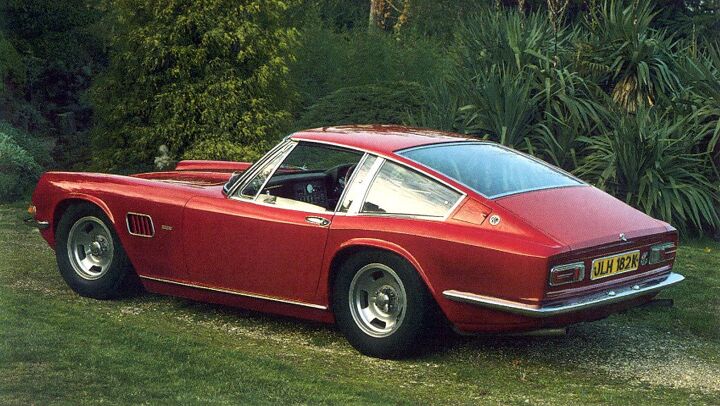Rare Rides: The Beautiful 1969 AC Frua Cabriolet

Today’s Rare Ride was in production for nine years, but never reached triple-digit figures in its sales.
Let’s check out this hand-crafted British beauty.
AC is one of the oldest living independent British car firms and traces its roots back to London in 1901. Originally known as Auto Carriers, Ltd., the company has gone through too many liquidations and reorganizations to count. Always a specialty car maker, AC built mostly three-wheelers and luxurious sports coupes and is most notable for its collaboration with Carroll Shelby to develop the AC Cobra.
The Mark III version of the Cobra ended its production in 1967, but by that time AC had morphed it into a new sports luxury coupe of its own. With a long, flowing body designed by Pietro Frua, the AC Frua (also called AC 427 and AC 428) debuted in 1965.
Designed on a very tight budget, the new body rode on an AC Cobra chassis that was extended by six inches. The chassis was assembled by AC and then shipped to Frua in Italy where the hand-built bodies were fitted. Mostly made of steel, hoods and trunk lids were aluminum. The conjoined body and chassis went back to England, where AC installed the interior and mechanicals.
Said mechanicals included a 428 cubic-inch Ford V8, paired to a three-speed auto or four-speed manual transmission. Unlike other low-volume coachbuilt coupes of the period, the AC had an independent, racing-developed coil spring suspension. Also similar to its competitors, the Frua was a bit half-baked in its design. The huge engine up front tended to send its heat seeping into the cabin, making for warm drives all the time.
With its considerable grunt, the Frua mixed luxury company with cars from Monteverdi and De Tomaso, but performed more like a Ferrari or Lamborghini. And like those latter Italians, the AC Frua was very expensive: Circa 1965 it was twice the price of a 4.2-equipped Jaguar E-type.
The price and hand-built nature meant few customers were found for AC’s Frua. It didn’t have the legacy name to compete with the established Italians, and other low-volume cars were better made. As a result, when production ended in 1973 just 81 had been completed. Of those, 49 were coupes, 29 convertibles, and 3 wore one-off bodies. The Frua was AC’s last car for some time, as production of the 3000ME didn’t start until 1979.
Today’s Rare Ride is a beautiful teal cabriolet from 1969. With automatic and right-hand drive, it’s priced in the UK upon request.
[Image: AC]

Interested in lots of cars and their various historical contexts. Started writing articles for TTAC in late 2016, when my first posts were QOTDs. From there I started a few new series like Rare Rides, Buy/Drive/Burn, Abandoned History, and most recently Rare Rides Icons. Operating from a home base in Cincinnati, Ohio, a relative auto journalist dead zone. Many of my articles are prompted by something I'll see on social media that sparks my interest and causes me to research. Finding articles and information from the early days of the internet and beyond that covers the little details lost to time: trim packages, color and wheel choices, interior fabrics. Beyond those, I'm fascinated by automotive industry experiments, both failures and successes. Lately I've taken an interest in AI, and generating "what if" type images for car models long dead. Reincarnating a modern Toyota Paseo, Lincoln Mark IX, or Isuzu Trooper through a text prompt is fun. Fun to post them on Twitter too, and watch people overreact. To that end, the social media I use most is Twitter, @CoreyLewis86. I also contribute pieces for Forbes Wheels and Forbes Home.
More by Corey Lewis
Latest Car Reviews
Read moreLatest Product Reviews
Read moreRecent Comments
- SCE to AUX All that lift makes for an easy rollover of your $70k truck.
- SCE to AUX My son cross-shopped the RAV4 and Model Y, then bought the Y. To their surprise, they hated the RAV4.
- SCE to AUX I'm already driving the cheap EV (19 Ioniq EV).$30k MSRP in late 2018, $23k after subsidy at lease (no tax hassle)$549/year insurance$40 in electricity to drive 1000 miles/month66k miles, no range lossAffordable 16" tiresVirtually no maintenance expensesHyundai (for example) has dramatically cut prices on their EVs, so you can get a 361-mile Ioniq 6 in the high 30s right now.But ask me if I'd go to the Subaru brand if one was affordable, and the answer is no.
- David Murilee Martin, These Toyota Vans were absolute garbage. As the labor even basic service cost 400% as much as servicing a VW Vanagon or American minivan. A skilled Toyota tech would take about 2.5 hours just to change the air cleaner. Also they also broke often, as they overheated and warped the engine and boiled the automatic transmission...
- Marcr My wife and I mostly work from home (or use public transit), the kid is grown, and we no longer do road trips of more than 150 miles or so. Our one car mostly gets used for local errands and the occasional airport pickup. The first non-Tesla, non-Mini, non-Fiat, non-Kia/Hyundai, non-GM (I do have my biases) small fun-to-drive hatchback EV with 200+ mile range, instrument display behind the wheel where it belongs and actual knobs for oft-used functions for under $35K will get our money. What we really want is a proper 21st century equivalent of the original Honda Civic. The Volvo EX30 is close and may end up being the compromise choice.


































Comments
Join the conversation
"The chassis was assembled by AC and then shipped to Frua in Italy where the hand-built bodies were fitted... The conjoined body and chassis went back to England, where AC installed the interior and mechanicals." Lesson from history: If your body assembly process crosses international borders, you are going to have some inefficiencies. (Ideally, try to keep it within one building.) A more recent example: https://www.hemmings.com/stories/article/1987-93-cadillac-allante